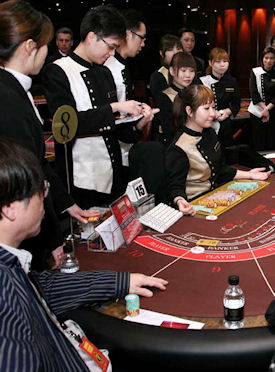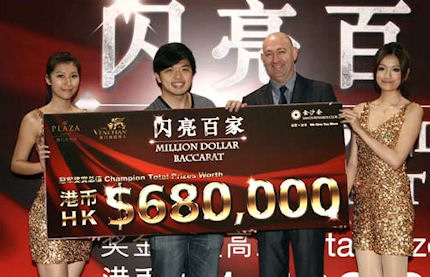This article first appeared in the Nov/Dec 2011 issue of World Gaming magazine.
There have been millions of words published on the many techniques for winning poker tournaments, but very little is in print about how to win a baccarat tournament. Our tournament baccarat guru Andrew W Scott shares his strategies on this little understood topic.

Welcome to part E of this series. Visit World Gaming’s website wgm8.com if you need to catch up on parts A, B, C and D, which explained:
- introductory concepts such as the three distinct phases of any baccarat tournament: the early going, the middle going and the late going,
- how to know which phase you were in at any given time,
- the strategies to implement during the early going, and
- “the progression”, a powerful “chasing” technique that can be used in the early and middle going.
Rounds
Tournaments are split into “rounds” (which usually have names like “heats”, “semi-finals” or “finals”). At the end of each round, some players are eliminated and the others progress to the next round of the tournament. Of course during the round the players know the number of players who will progress. For example, there might be eight players in a heat with the four largest stacks at the end of the round progressing to a semifinal, with the four smallest stacks eliminated. In this case all eight players are striving to finish the round with one of the four biggest stacks.
The middle going
The middle going is the “meat and potatoes” part of any baccarat tournament, where your skill advantage over your opponents really manifests itself. It generally starts with about ten hands remaining in the round and ends with the second last hand of the round (refer to part B for an explanation of how to track the number of hands remaining at any given time). Whilst your goal in the early going is to stay out of trouble and allow your opponents to blast out (refer to part C for a fuller explanation), you have no such luxury in the middle going. At the start of the middle going it’s time to take stock of where you are at, and begin jockeying for those all-important star positions.
Star position
The first question you need to ask yourself is “am I in a star position now?” Another way of asking the same question is “if the round were to end this instant, would I make it through to the next round?” If the answer is yes, you are in a star position. Your goal is to stay there. If your answer is no, you are not in a star position. Your goal is to get there. Refer to part B for a more thorough explanation of the term “star position”.
Most serious opponent
The next thing to do is to identify who your “most serious opponent” is. In practice we usually focus on one “most serious opponent”, but you often have more than one serious opponent to consider. Typically, if you are in star position, your most serious opponent is the biggest stack who is not in a star position, in other words the player most likely to rise into a star position and perhaps knock you out in the process. If you are not in a star position, typically your most serious opponent is the smallest stack who is in a star position, in other words the player you need to get in front of to move into a star position.
In practice, your “most serious opponent” often changes from hand to hand and usually you don’t have just one “most serious opponent”, but several “most serious opponents”. However, these “most serious opponents” will have similar stack sizes. Skilled tournament baccarat players often refer to their opponents as “moving targets”, but you should remember they are targets that can only move a certain distance each hand, depending on their bet size for that hand.

Bet first or last
Having identified your “most serious opponent(s)”, you must then determine whether you bet before or after him or them. This is easy to do if there is just one “most serious opponent”. There is a predetermined betting order usually signified by a “first bet” marker (not unlike the “button” in poker, but this marker indicates the player who bets first rather than the player who bets last). Also note that the betting order and the movement of the “first bet” marker around the table is usually anti-clockwise, whereas in poker both the betting and the button move clockwise.
Determining whether you bet first or last is sometimes not so clear if you have multiple “most serious opponents”. Sometimes one (or some) of these opponents bet before you and one (or some) bet after you. Here’s an example. Let’s say you are playing a semi-final and only seven players remain alive. The top four stacks will progress to the next round. The maximum bet is 50k. Your stack is 52k in chips and the three chip leaders have 312k, 257k and 144k. There are three small stacks with 45k, 38k and 10k. I hope you can see the players with 312k, 257k, 144k and 10k are irrelevant, at least for the next hand. In this example there are three players (you, Mr 45k and Mr 38k) jockeying for the fourth and last available star position. Let’s say your opponent with 38k has already moved all-in ahead of you, it’s your turn to bet, and Mr 45k bets after you. Who is your most serious opponent? You would normally say it is Mr 45k (since you are in a star position and he is the biggest stack not in a star position), but Mr 38k isn’t far behind at all and has already moved all-in. If he wins his bet he will move to around 76k and take the star position from you unless you do something about it. In this case you might decide Mr 38k is your most serious opponent, especially if Mr 45k is very timid and hasn’t been betting big.
Determining your most serious opponent sometimes requires considering multiple factors. Sometimes you have multiple “most serious opponents” but they all bet before you (or they all bet after you), so that makes it easy to determine whether you bet first or last.
The four strategies
Once you determine your most serious opponent (or opponents), and whether you bet first or last in comparison to him (or them), you’ll be able to classify yourself at the start of each hand in the middle going as being in one of four situations:
- Star position and betting last
- Star position and betting first
- Not star position and betting last
- Not star position and betting first
Each of these four situations has a distinct strategy appropriate to the situation. We’ll explain those four strategies in part F of this series.
Where to get your baccarat tournament fixBaccarat tournaments will be one of the fastest growing Asian gaming areas over the next few years. You can already find baccarat tournaments in Macau and Manila, with the Venetian Macau, the Plaza and the Sands Macau leading the way by holding their flagship King of Baccarat tournament annually since 2008.  The winner Mr Tse with his winner’s cheque On September 17 The Venetian ran their Venetian Macao Million Baccarat Tournament. The winner Mr Tse was awarded HK$680,000 and the much heralded title. Nearly 200 players competed, with the top eight players receiving prize money totaling more than HK$1.5 million. This tournament came hot on the heels of the September 3 Sands Macao Baccarat Tournament, which featured a grand total of more than HK$1 million cash in prize money along with a first prize of HK$500,000. Make sure you sign up to The Sands Rewards Club for more information. Get yourself a seat at the tournament baccarat table, and you’ll be in with a chance to share in the millions on offer in prize money. Baccarat tournaments are also a Resorts World Manila specialty. RWM holds about six invitational tournaments a year for their bigger players. Prize pools for the tourneys range from about HK$3 million to about HK$10 million. This is the kind of action that will really put a smile on your face if you are lucky enough to come away with the title. World Gaming magazine and our website wgm8.com will do everything we can to endorse and promote top quality baccarat tournaments in Asia, and we invite casinos to work with us in promoting the exciting tournament baccarat concept. Give players what they want by offering them the chance to walk away with life changing amounts of money. |







